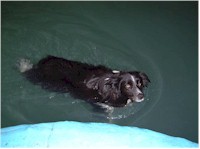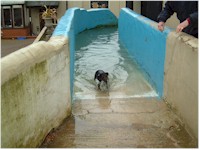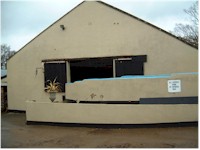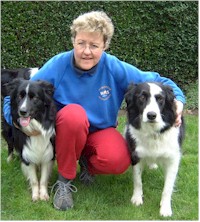|
From Sam
Watts
We swim
our four dogs weekly. It all started when our Tiegan suffered an injury to her hip
(probably when still with her mother) We noted a problem when she was about five months
old, fearing the worst, Hip Dysplasia. Our vets agreed to x-ray her immediately rather than
'wait and see.' She wasn't clinically lame, only squeaked occasionally whilst drying.
The x-rays showed a unilateral deficit in muscle and poor socket
formation to the one side. Our vet gave me three options:-
-
Wait and see.
-
Surgery at a year old, either excision arthroplasty, removing
the hip joint, or a triple pelvic osteotomy to reposition the acetabulum (cup joint of
the hip)
-
Swimming.
Guess which we chose. Our vet had
no idea where! and suggested a friendly house owner with a pool. I rang around and finally
rang the Royal Veterinary College. They had only two swimming pools on their records one in
Cambridge and Stokenchurch. Stokenchurch is a little under a hour's journey but all the
late nights and driving, not to mention the cost, has been worth every penny.
Tiegan swam twice a week for 30
minutes. Happily her follow-up x-rays at 12 months showed a normal hip joint formation and
an incredibly fit dog! During the time we visited an osteopath monthly to ensure we were
not doing any damage upon the advise of our vet.
We are now swimming all our dogs
who not only thoroughly enjoy it (all manners are lost and the last 10 minutes of the
journey are hell on our ear drums!) and are so much fitter without hammering their joints.
I would recommend swimming to all owners of working dogs and more and more veterinary
surgeons are recommending swimming as a physiotherapy treatment for post-skeletal surgery
and fitness regime for returning to work, not to mention older dogs with conditions such as
hip dysplasia.
We were lucky to have noted a
potential problem early enough to do something and to have a veterinary surgeon who agreed
to x-ray and suggest an alternative treatment. He knows how mad our family is about agility
and would do anything possible for our dogs.
We believe that swimming has
benefited all our dogs. We find their fitness levels are superb and touching wood have had
no skeletal or lameness problems. I am convinced a large number of lameness and joint
problems in agility dogs are due to lack of fitness and weight.
As for Tiegan, she competed in
her first show at Ribble last year and had a five fault round in the Chum!! The whole
family were on such a high for the journey home the three hours flew by! She went on to
Senior in her first year and is now enjoying continued success in that group. No one
believes Tiegan ever had a problem. We obviously had her spayed as soon as it became clear
that she had a potential problem. The vet is thrilled with her and does not foresee any
problems in the future. (12/06/01) |
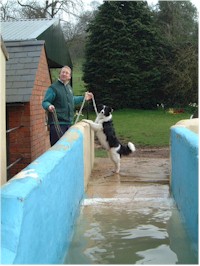 In
any action sport, whether it involves humans or animals, it is a well-known fact that the
fitter the participants are the less likely it is for injuries to occur. Since our canine
friends are unable to tell us how well they are feeling, it is beholden on us to monitor them
carefully and keep them fit and trim. However, due to the foot and mouth crisis, many agility
dogs are losing their fitness from lack of off-lead running, regular training and competitions.
This will result in both dogs and humans sustaining pulled muscles and other injuries when we
can finally return to training/competing. With this in mind, Sally Hopkins recommends a dip in
the pool.
In
any action sport, whether it involves humans or animals, it is a well-known fact that the
fitter the participants are the less likely it is for injuries to occur. Since our canine
friends are unable to tell us how well they are feeling, it is beholden on us to monitor them
carefully and keep them fit and trim. However, due to the foot and mouth crisis, many agility
dogs are losing their fitness from lack of off-lead running, regular training and competitions.
This will result in both dogs and humans sustaining pulled muscles and other injuries when we
can finally return to training/competing. With this in mind, Sally Hopkins recommends a dip in
the pool.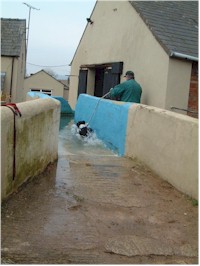
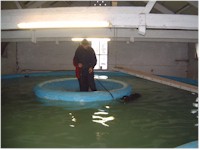 Jim Wilson, the owner of the
yard and pool, has over twenty years experience of swimming
horses
and dogs. He is a great believer in starting a dog off on just a few circuits each way, asking
the owner to monitor the dog’s tiredness both later in the day and the following day too. One
of his favorite sayings is “It is better to do less and do more later than to do too much and
do harm” which gives you a good indication of how much importance he puts on the dog’s
well-being. Over a period of weeks, as the dog becomes fitter, Jim increases the time the dog
swims to eight to ten minutes, depending on whether the dog swims calmly and steadily (which is
best) or whether the dog swims faster.
Jim Wilson, the owner of the
yard and pool, has over twenty years experience of swimming
horses
and dogs. He is a great believer in starting a dog off on just a few circuits each way, asking
the owner to monitor the dog’s tiredness both later in the day and the following day too. One
of his favorite sayings is “It is better to do less and do more later than to do too much and
do harm” which gives you a good indication of how much importance he puts on the dog’s
well-being. Over a period of weeks, as the dog becomes fitter, Jim increases the time the dog
swims to eight to ten minutes, depending on whether the dog swims calmly and steadily (which is
best) or whether the dog swims faster.